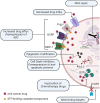Electrochemotherapy for head and neck cancers: possibilities and limitations
- PMID: 38434679
- PMCID: PMC10905418
- DOI: 10.3389/fonc.2024.1353800
Electrochemotherapy for head and neck cancers: possibilities and limitations
Abstract
Head and neck cancer continues to be among the most prevalent types of cancer globally, yet it can be managed with appropriate treatment approaches. Presently, chemotherapy and radiotherapy stand as the primary treatment modalities for various groups and regions affected by head and neck cancer. Nonetheless, these treatments are linked to adverse side effects in patients. Moreover, due to tumor resistance to multiple drugs (both intrinsic and extrinsic) and radiotherapy, along with numerous other factors, recurrences or metastases often occur. Electrochemotherapy (ECT) emerges as a clinically proven alternative that offers high efficacy, localized effect, and diminished negative factors. Electrochemotherapy involves the treatment of solid tumors by combining a non-permeable cytotoxic drug, such as bleomycin, with a locally administered pulsed electric field (PEF). It is crucial to employ this method effectively by utilizing optimal PEF protocols and drugs at concentrations that do not possess inherent cytotoxic properties. This review emphasizes an examination of diverse clinical practices of ECT concerning head and neck cancer. It specifically delves into the treatment procedure, the choice of anti-cancer drugs, pre-treatment planning, PEF protocols, and electroporation electrodes as well as the efficacy of tumor response to the treatment and encountered obstacles. We have also highlighted the significance of assessing the spatial electric field distribution in both tumor and adjacent tissues prior to treatment as it plays a pivotal role in determining treatment success. Finally, we compare the ECT methodology to conventional treatments to highlight the potential for improvement and to facilitate popularization of the technique in the area of head and neck cancers where it is not widespread yet while it is not the case with other cancer types.
Keywords: FEM analysis; electrochemotherapy; head and neck cancer; pulsed electric fields; tumors.
Copyright © 2024 Morozas, Malyško-Ptašinskė, Kulbacka, Ivaška, Ivaškienė and Novickij.
Conflict of interest statement
The authors declare that the research was conducted in the absence of any commercial or financial relationships that could be construed as a potential conflict of interest.
Figures






Similar articles
-
Electrochemotherapy in the head and neck area: an addition to the treatment armamentarium.Curr Opin Otolaryngol Head Neck Surg. 2020 Apr;28(2):112-117. doi: 10.1097/MOO.0000000000000609. Curr Opin Otolaryngol Head Neck Surg. 2020. PMID: 32102006 Review.
-
Electrochemotherapy for non-melanoma head and neck cancers: clinical outcomes in 25 patients.Ann Surg. 2012 Jun;255(6):1158-64. doi: 10.1097/SLA.0b013e31824f68b2. Ann Surg. 2012. PMID: 22549747
-
Synergistic In Vitro Anticancer Toxicity of Pulsed Electric Fields and Glutathione.Int J Mol Sci. 2022 Nov 25;23(23):14772. doi: 10.3390/ijms232314772. Int J Mol Sci. 2022. PMID: 36499100 Free PMC article.
-
Electroporation-based treatments in minimally invasive percutaneous, laparoscopy and endoscopy procedures for treatment of deep-seated tumors.Eur Rev Med Pharmacol Sci. 2021 May;25(9):3536-3545. doi: 10.26355/eurrev_202105_25836. Eur Rev Med Pharmacol Sci. 2021. PMID: 34002828
-
Electroporation in Head-and-Neck Cancer: An Innovative Approach with Immunotherapy and Nanotechnology Combination.Cancers (Basel). 2022 Oct 31;14(21):5363. doi: 10.3390/cancers14215363. Cancers (Basel). 2022. PMID: 36358782 Free PMC article. Review.
Cited by
-
Minimally Invasive Plasma Device Management of Multiple Benign Skin Cancers Associated with Rare Genodermatoses-Case Series and Review of the Therapeutic Methods.J Clin Med. 2024 Jul 26;13(15):4377. doi: 10.3390/jcm13154377. J Clin Med. 2024. PMID: 39124644 Free PMC article.
References
Publication types
LinkOut - more resources
Full Text Sources

